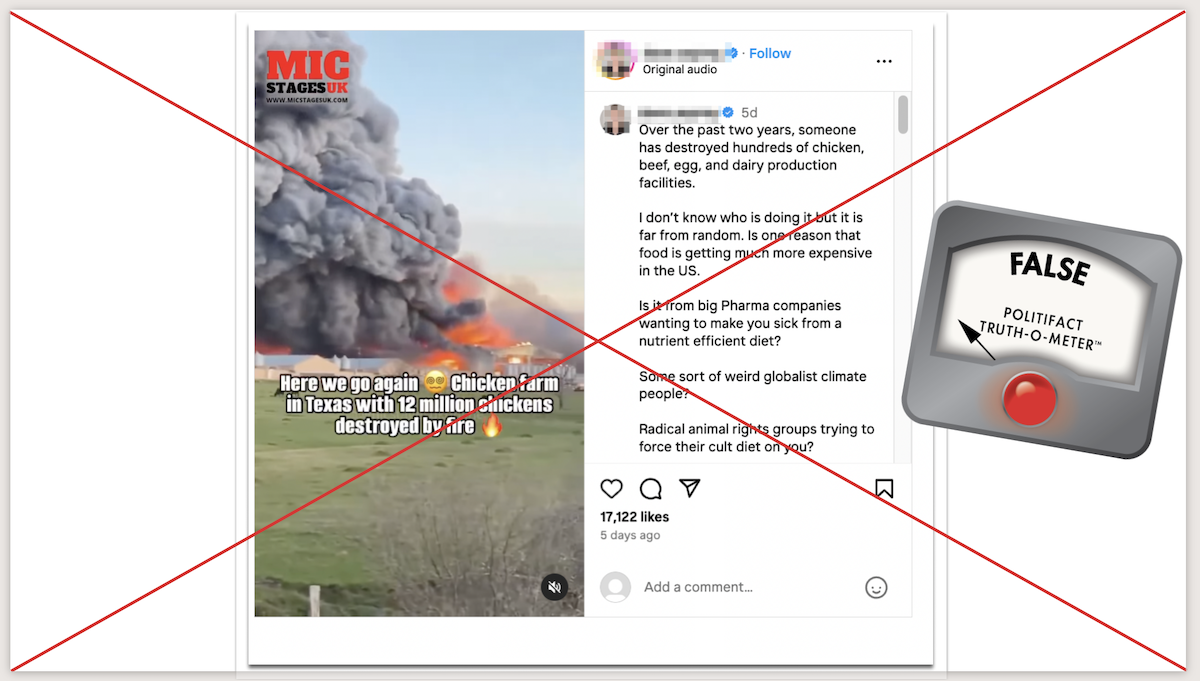Where there’s smoke, there may be fire … or conspiracy theories. At least there were after a massive fire at a Texas chicken farm resurfaced a long-running notion that anonymous forces are destroying farms and food production facilities to limit the food supply.
“Here we go again,” read the sticker text on a Feb. 21 Instagram video that showed a chicken farm up in flames. “Chicken farm in Texas with 12 million chickens destroyed by fire.”
The post’s caption said, “Over the past two years, someone has destroyed hundreds of chicken, beef, egg, and dairy production facilities. I don’t know who is doing it but it is far from random. Is one reason that food is getting much more expensive in the US.”
The caption named a number of possible villains, from “big pharma companies wanting to make you sick” to “weird globalist climate people.”
The video came from a Feb. 17 Instagram post from MicstagesUK, a British news and entertainment website. We found numerous social media posts sharing the video or making similar claims.
PolitiFact has debunked multiple similar claims since 2022 and found that authorities did not deem most fires suspicious; most of the fires were likely accidental, caused by electrical or mechanical failures.
A Jan. 29 fire at Feather Crest Farms outside of Bryan, Texas, destroyed two chicken houses, including one full of chickens, news outlets reported. As with previous fires we’ve investigated, there was nothing intentional about the fire, authorities said.
(Instagram screenshot)
Authorities have not yet determined the chicken farm fire’s cause, but the Brazos County Sheriff’s Office determined it was a “noncriminal accident,” according to news reports.
Deputy Chris Searles told KBTX-TV that, “Somebody didn’t throw a match into the pile or anything. Sometimes it’s just we cannot figure out exactly what happened.”
Sam Krouse, CEO of MPS Egg Farms, which owns Feather Crest Farms, confirmed to PolitiFact in an email that authorities determined the fire was accidental, and said the cause is still under investigation.
Krouse said the company is not disclosing the number of chickens killed, “but it is far less than 12 million.”
That number “reflects our total number of laying hens nationwide, not the number in the one barn impacted by the fire,” he said.
Although how many chickens died in the fire is unclear, similar fires in recent years have killed tens of thousands of chickens. A 2022 fire that destroyed one chicken house at a Lebanon, Pennsylvania, farm killed about 250,000 chickens. A 2023 fire in a Bozrah, Connecticut, chicken coop killed about 100,000 chickens.
Fires at chicken farms and food processing plants are common. A 2022 National Fire Protection Association report found that from 2014 to 2018, there were about 930 structure fires annually at livestock or poultry storage facilities, which includes barns, stockyards and animal pens. Heating equipment or electrical equipment malfunctions were those fires’ leading causes, the report said.
Birgitte Messerschmidt, the association’s research director, told PolitiFact in 2022 that fires at food production sites are “nothing out of the ordinary.”
Animal Welfare Institute data shows that in 2023, more than 480,000 animals were killed in barn fires. That total includes about 300,000 chickens killed in fires at farms in Connecticut and Delaware. In 2020, 1.6 million animals died in barn fires, the institute said.
So far this year, more than 31,000 farm animals have died in fires, the institute said. Its data counted 10,000 chickens killed in the Texas fire but noted that the number is believed to be much higher.
The institute’s 2022 report on barn fires said “improper use of or malfunctioning heating devices and other electrical malfunctions” were suspected or determined to be what caused most of the fires.
Our ruling
An Instagram post claimed a Texas farm fire that killed 12 million chickens was part of a larger conspiracy to attack the nation’s food supply. The number of chickens killed, although undisclosed, was far fewer, said the farm’s CEO. And authorities have ruled the fire a “noncriminal accident.”
The claim is False.
